Warning: Undefined variable $k in /home/nginx/domains/wired2fishcom.bigscoots-staging.com/public/wp-content/themes/understrap-child-0.6.0/functions.php on line 984
Warning: Undefined variable $k in /home/nginx/domains/wired2fishcom.bigscoots-staging.com/public/wp-content/themes/understrap-child-0.6.0/functions.php on line 987
Have you ever watched someone expertly cast a fly rod, their line gracefully whipping through the air like Luke Skywalker’s lightsaber, and thought, “That looks as tricky as trying to hit a womp rat in my T-16 back home?”
Well, fellow would-be Jedi anglers, you’re not alone. But here’s the surprising truth: mastering the art of fly casting is less about ancient Force techniques and more about timing and understanding the basics. By the end of this article, you’ll realize that casting a fly is easier than convincing a Stormtrooper he saw nothing unusual.
If you normally fish with a spinning reel or a baitcaster, then you may have a bit of casting muscle memory to overcome when first casting a fly rod. Understanding the difference between how a lure or fly is delivered to the target will make all the difference in overcoming that memory.
So grab your fly fishing gear and let us get started. And for the record, you don’t need the expensive new fly fishing gear to get started or to have a bunch of fun. Grab your granddad’s rod or pickup a good fly fishing starter combo and just get started perfecting your fly casting.
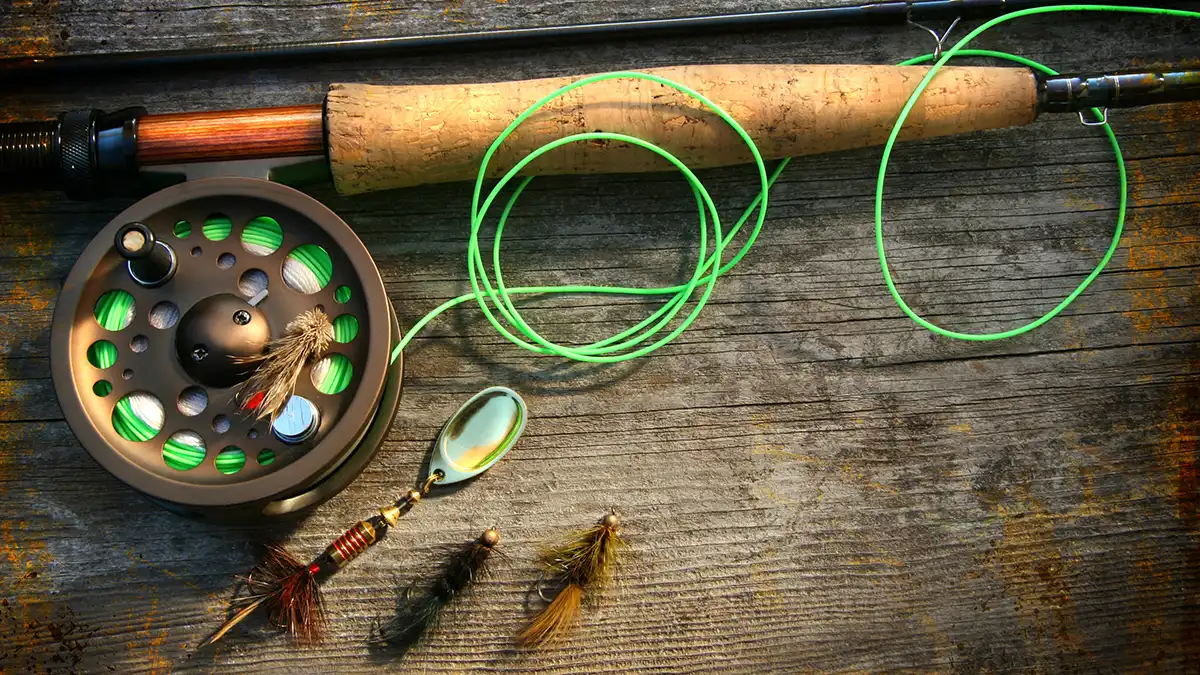
CASTING A LURE AND A FLY ARE NOT THE SAME
For the sake of this article, let’s call fishing with a spinning reel or baitcaster “conventional.” With a conventional setup, it’s the weight of the lure that carries the lure to the target, so there’s virtually no back cast. You just chuck the lure out there as far as its weight will carry it. What makes fly fishing different is that the fly line is weighted, not the fly. It’s the weight of the line that carries the fly to the target. This is why you see fly anglers on the water holding so much line in the air. They are letting more line out to get their fly to the target.
Many new fly anglers will find they make a bad cast because they use too much force or strength in their cast from conventional muscle memory and will overpower the rod. In fact, if you make a proper back cast, then most of the time the front cast will take care of itself.
It might surprise you to know that the current world casting champion is a young girl named Maxine McCormick, who won the title when she was 14 years old by casting 161 feet. This just goes to prove that making a good fly cast is not about power or strength. In fact, fly fishing has been an old, fat, rich man’s sport for eons. Think like Jabba – less effort is going to make a better cast.
Now that you know there’s no strength or force involved in the cast, how in the galaxy will you get the fly to the target? Let’s start with the very basics.
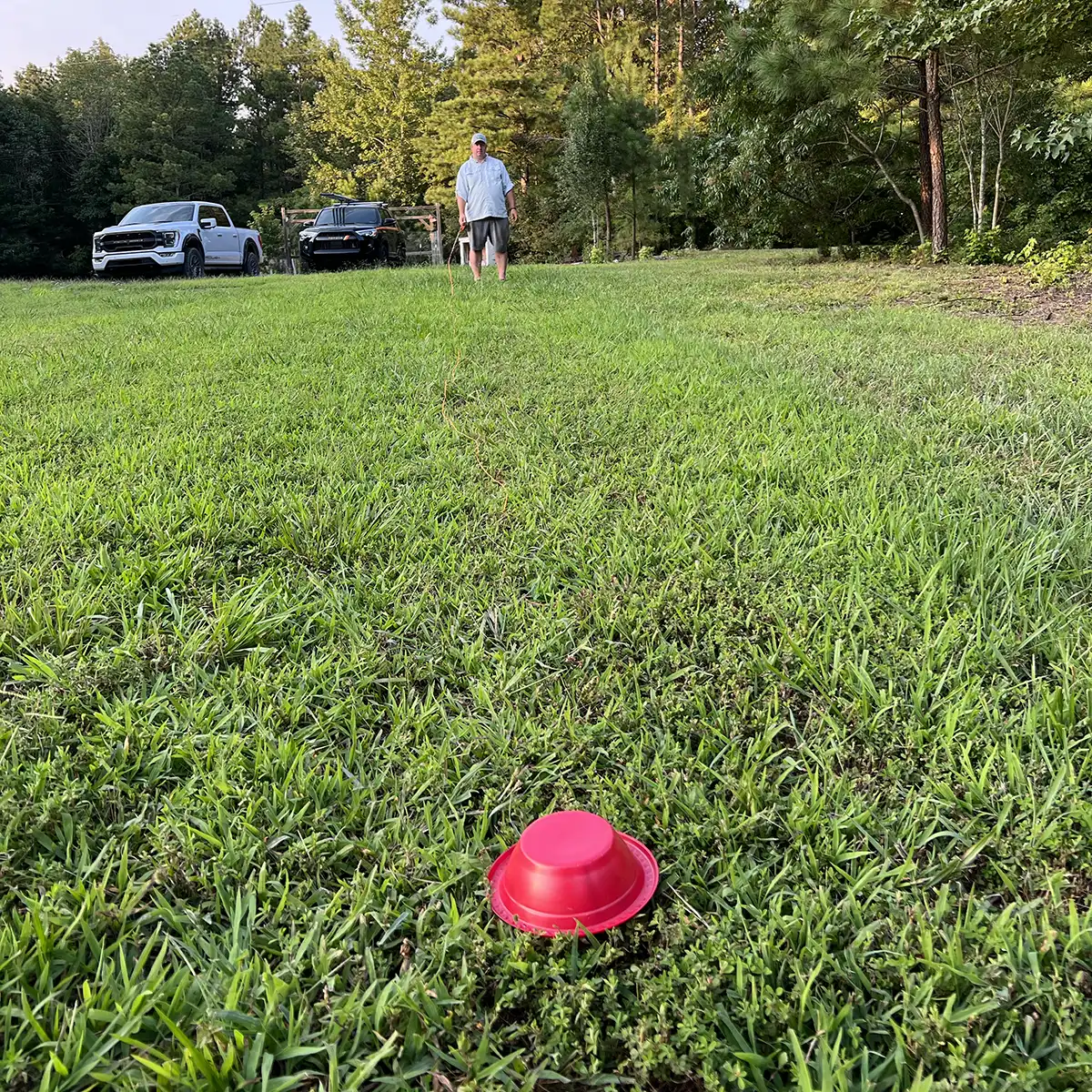
FLY CASTING AREA
I like to practice casting on a nice open, grassy area and give myself a target. For a target, I tend to use a hula hoop, but a plastic plate or even a big rock will work just fine. To start, pull about 20 feet of fly line out of the tip of the rod and laying it straight in front of you.
Make sure to have enough space in front and behind you so you can make your cast free and clear of any trees, structures or people. It will also be helpful to tie a small piece of yarn to the end of your tippet. This will imitate a fly on the end of your line but keep you, and those around you, safe from the sharp hook of a fly.
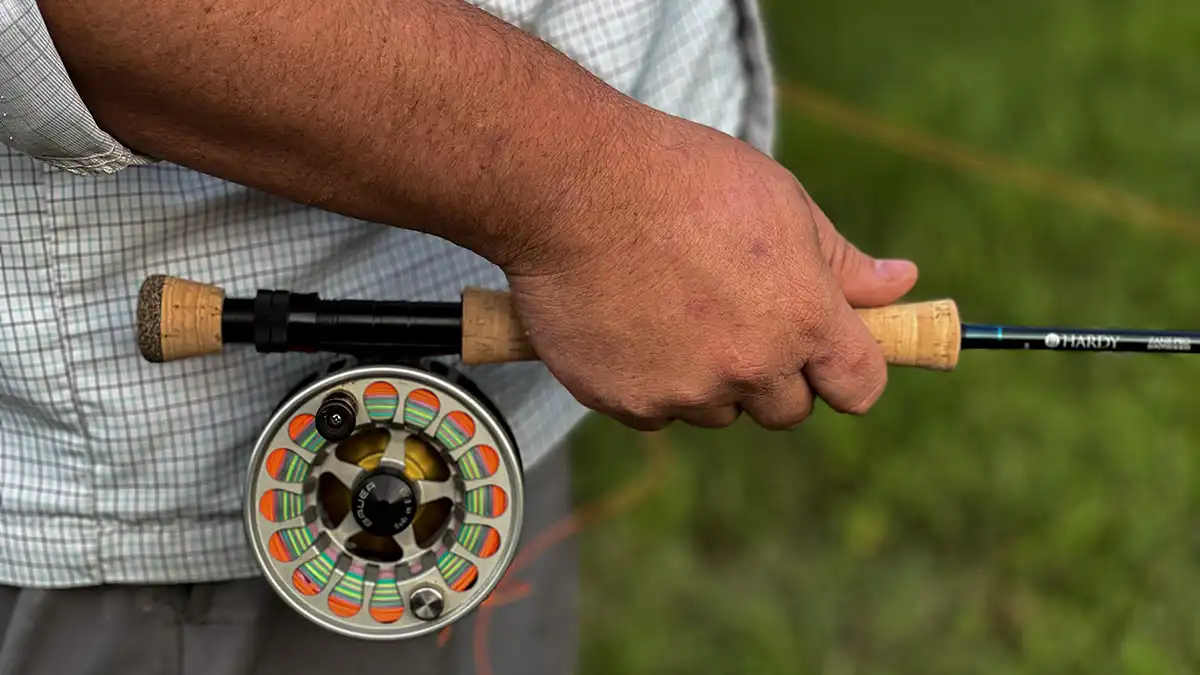
FLY CASTING GRIP AND STANCE
Pick up the rod and stand so your fly line on the grass is straight in front of you. You’re going to want to hold the fly rod like you would shake a friend’s hand. Your thumb should be on the top with your fingers wrapped underneath.
Fly fishing should be relaxing, so take the tension off your hand. Hold it firm but not a death grip. Stand with your feet shoulder-width apart, slightly angled toward your target. Eventually, you’ll find your own comfortable stance, but try this stance for starters.
BASIC OVERHEAD FLY CAST
While there are many different types of fly casts, the standard and most well-known of all fly casts is the Basic Overhead Fly Cast. This cast is what you think of when you hear fly fishing—that slow motion shot of that long line floating effortlessly above a fly angler on a river.
The Overhead Cast has four parts:
- The pickup
- The back cast
- The pause
- The forward cast

The cast starts with the rod tip low and near the grass. It might seem odd that your cast starts down low, but in a fishing situation, the fly rod tip is very close to or on the surface of the water to keep slack out of your line. We will talk about why in future articles, but for the sake of the cast, this is why your cast starts with the rod tip low. To do the pickup, lift your rod until the rod tip reaches the 10 o’clock position. It’s at this point that you’ll start your back cast.
To make a back cast, you’ll accelerate the rod tip backward from the 10 o’clock position to the 2 o’clock position, making an abrupt stop with the rod tip at the 2 o’clock position. I call this a quick acceleration to an abrupt stop. Try not to break your wrist but rather keep your wrist straight. You’ll notice that when you stop your rod tip at about the 2 o’clock position, your thumb will be right at your ear and your fly line will follow out the tip of the rod and start unrolling behind you.
Now, that backcast, young Padawan, is when you must have patience and pause, just for a brief second that will seem like forever, to allow the line to stretch out behind you before making your forward cast. If you move too quickly into the forward cast, you’ll hear the “snap” of your leader breaking the sound barrier as it whips around. This will be your auditory cue to pause just a little longer.
Note that the amount of pause will depend on how much line you’re casting. More line will take longer to stretch out completely behind you thus a longer pause is necessary.
Timing on the pause will come with experience, and you’ll learn what is too little or too much pause. Never pause long enough to let the line fall on the ground behind you. Once the line has stretched behind you, it’s time to start the forward cast.
The forward cast is made with the same motion as you made your back cast – that quick acceleration to an abrupt stop. You’ll want to bring the rod tip back to an abrupt stop at the 10 O’clock position again, which will let the line shoot out in front of you and lay down gently on the grass in front of you.
You’re now ready to begin your cast again.
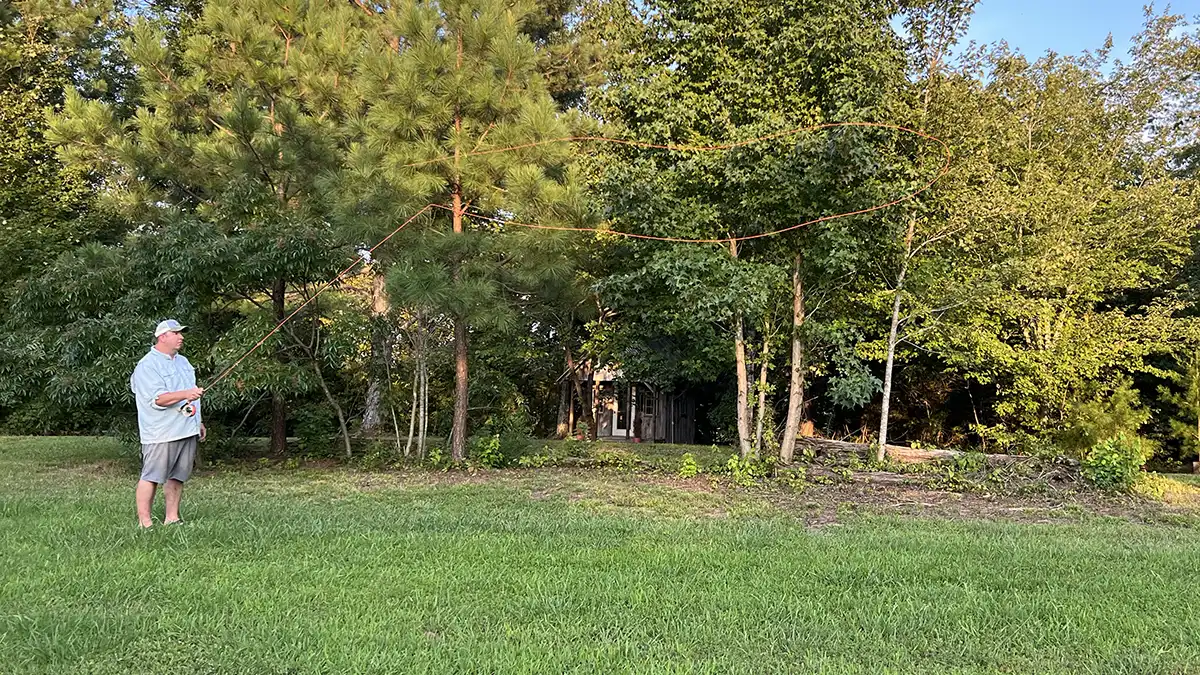
TIPS TO MASTER THE FLY CAST
- The rod tip should follow the same straight line back and forth between the 10 and 2 o’clock positions, as if you’re painting an imaginary line in the sky for your rod tip to follow.
- Start with shorter lengths of line and gradually increase the line length as you become more comfortable with your cast.
- The fly rod is made to continue to bend after you make the stop. It’s imperative to keep your stops as close to the 10 and 2 as possible, especially on the 2 o’clock back cast. It’s easy for even seasoned anglers to fall into the habit of “dropping your back cast.” For example, if you stop your rod tip at the 3 o’clock or 4 o’clock position, the rod will continue to flex a little after you stop and pummel your line into the ground behind you.
- Imagine yourself standing in a room with a paintbrush in your hand, and you’re going to splash paint on the back wall where the ceiling meets the wall on your back cast and splash paint on the front wall where the ceiling meets the wall for your front cast. This will help you make the stops necessary to make a good fly cast. After all, a good cast is all about the stops. Never imagine yourself painting the inside of an igloo with a roller.
- While it might seem helpful at first to watch your back cast to make sure the line isn’t touching the ground or your rod tip is stopping high enough, resist this urge. Taking your eyes off where you want the fly to land will just open your casting stroke and keep your rod tip from following that straight line.
- If you find that that line is looping over itself in front of you making a big circle, try easing up on the force of your forward stop. This is called a tailing loop and is usually fixed by less power on your front stop.
- Should the line start to pile up in front of you instead of laying out nicely in a line, try stopping the rod tip higher on your forward cast to let the line stretch out before bringing your rod tip back down for the next cast.
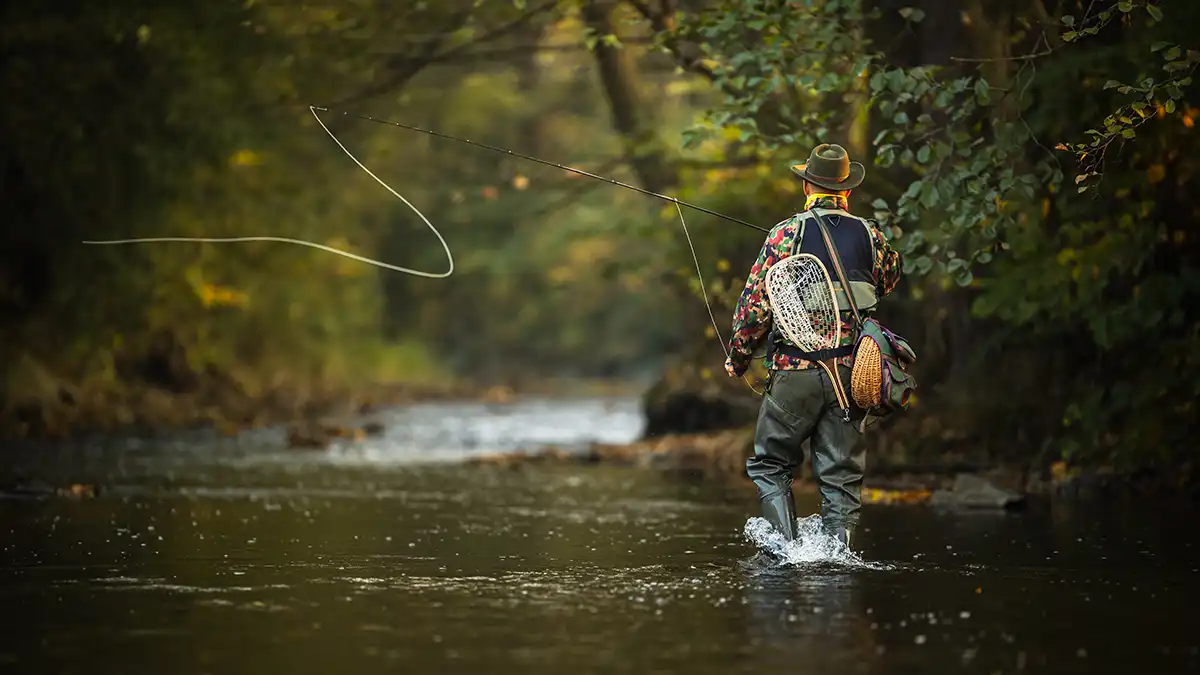
Remember, to be patient as you learn. No one makes a perfect cast all the time. Even very seasoned fly anglers make bad casts. Don’t ever let anyone tell you differently. And, if you happen to get tangled up in your fly line, that doesn’t mean you’re a terrible caster – it means you’re fly fishing.
Again, everyone regardless of skill level gets tangled up at some point. That is nothing to be embarrassed about. After all, fly fishing is fishing, and fishing is supposed to be fun. And it’s often unpredictable. Wind, obstructions, angles, tight windows, etc. all make for little mishaps here and there with any type of fishing or casting.
As you enter the vast galaxies of skills to master, remember the wise words of Master Yoda: ‘Do, or do not. There is no try.’
Practice is crucial. The good news is that fly casting is extremely fun. Spend time refining your technique and focus on timing and rhythm. Soon, the Overhead Cast will flow as effortlessly as the Force through a Jedi, and you’ll be off to the pond in no time.
May the fish be with you!
Check out the New Fly Fishing Gear for 2024!












